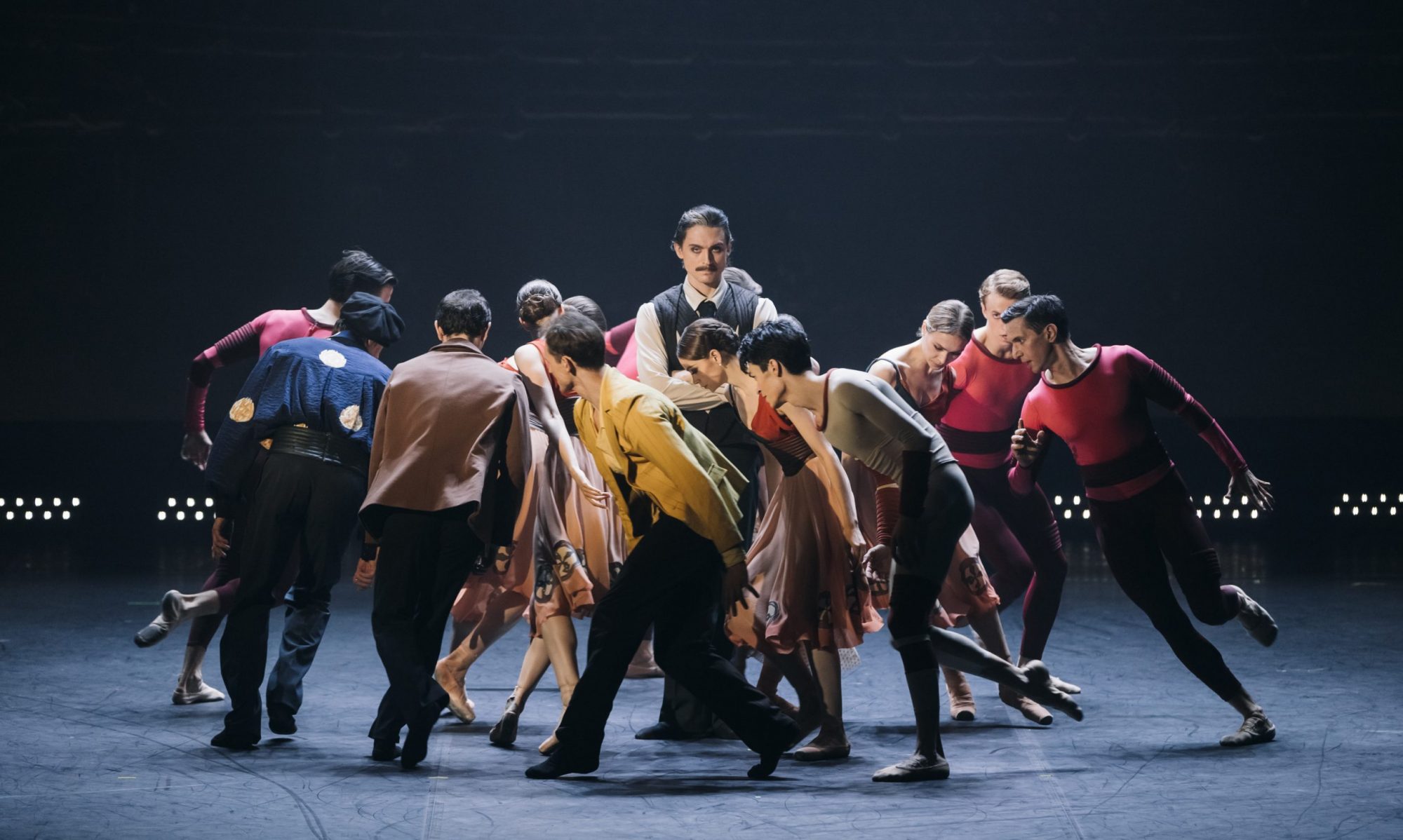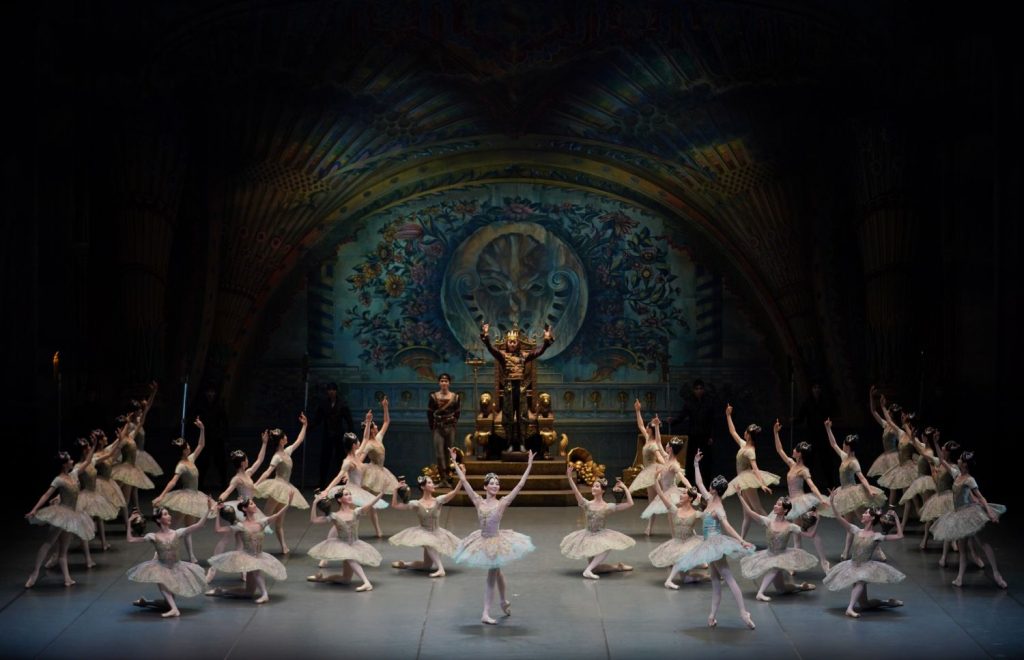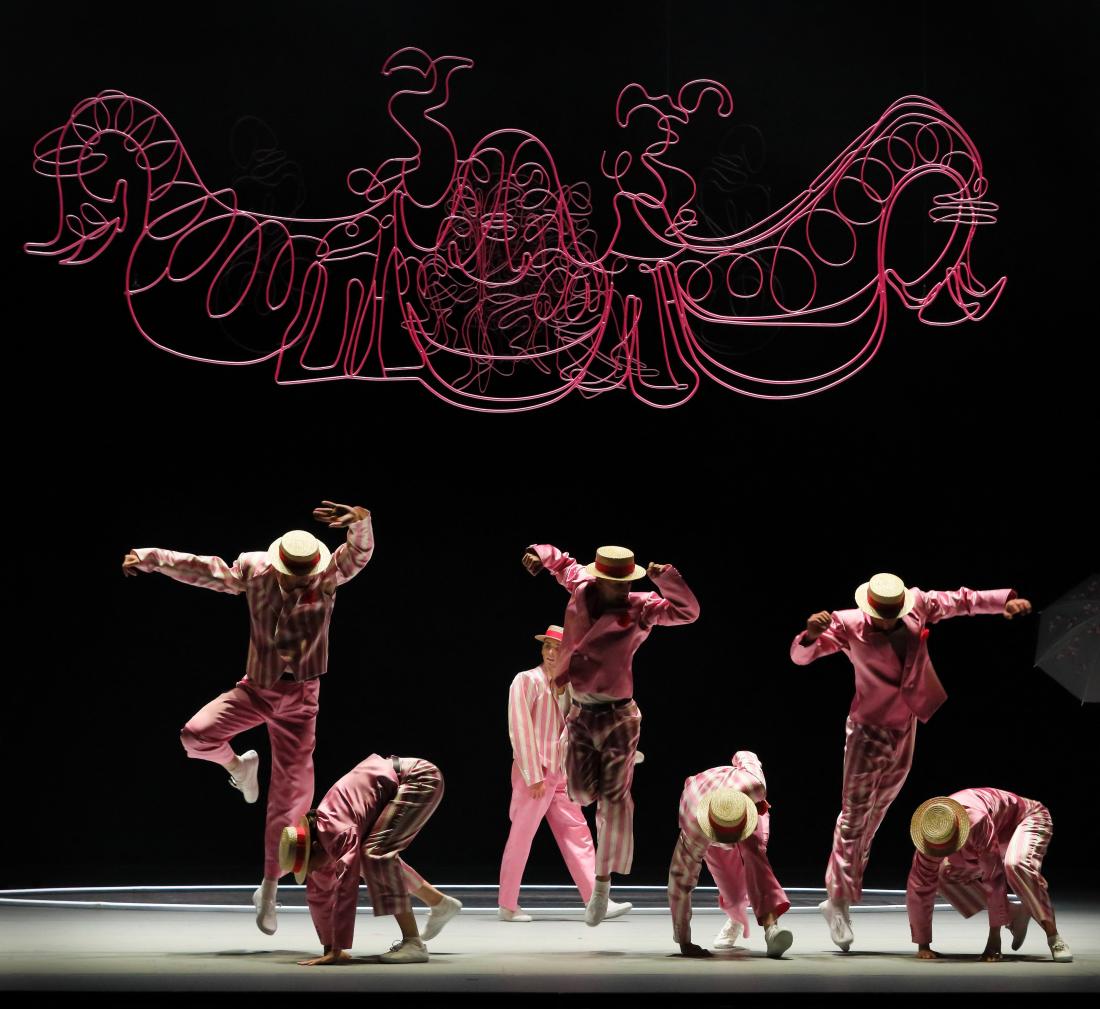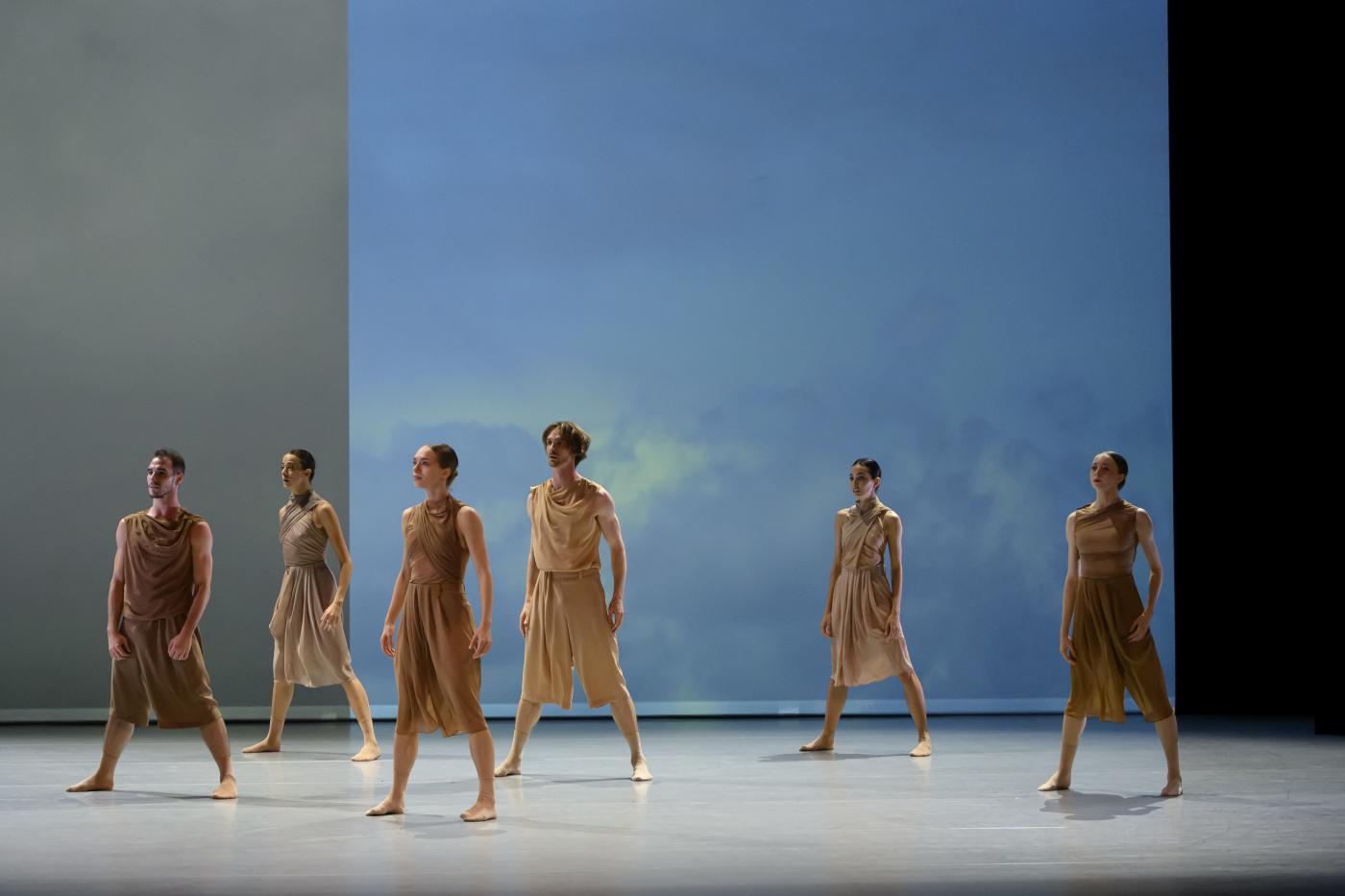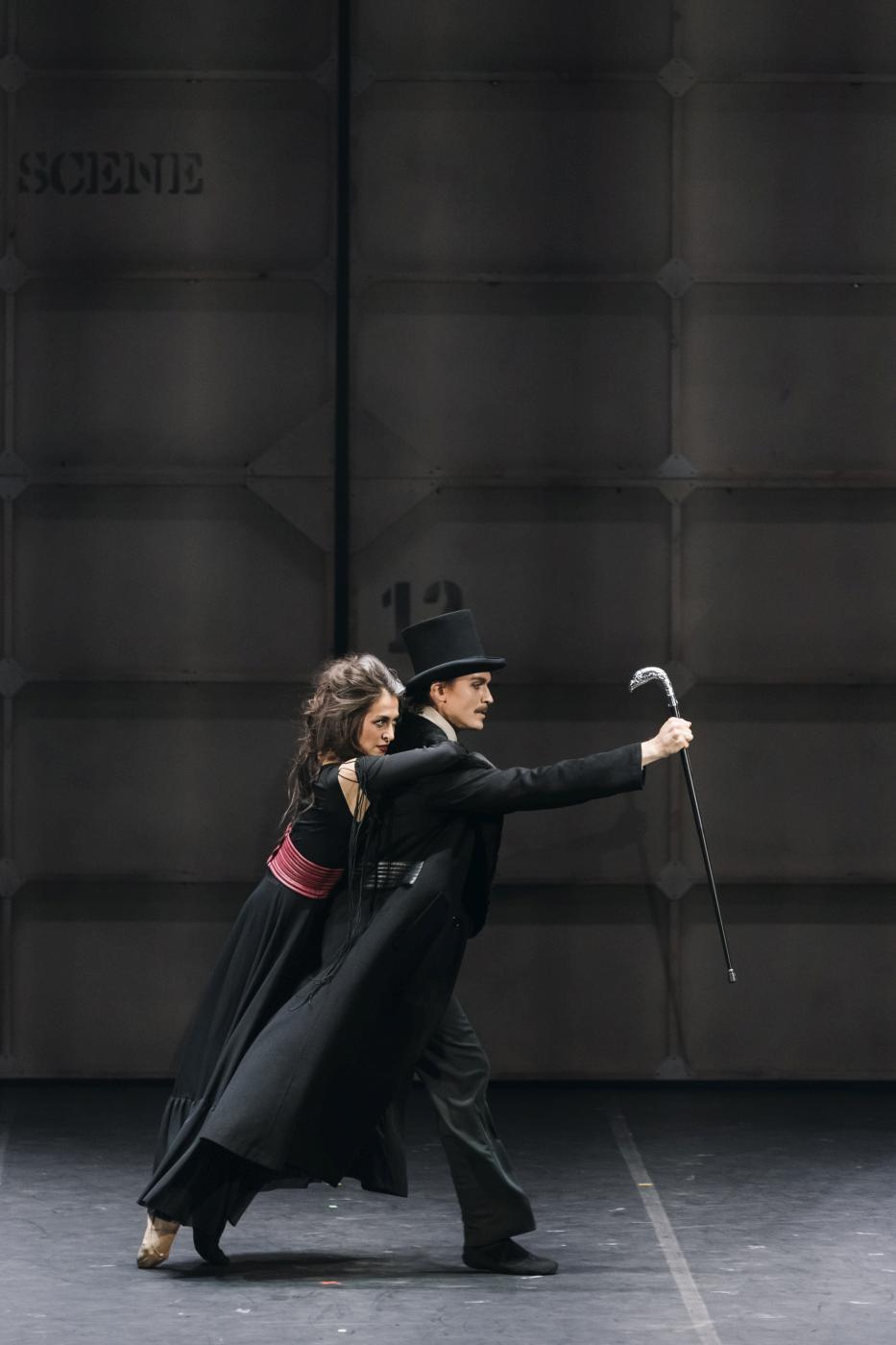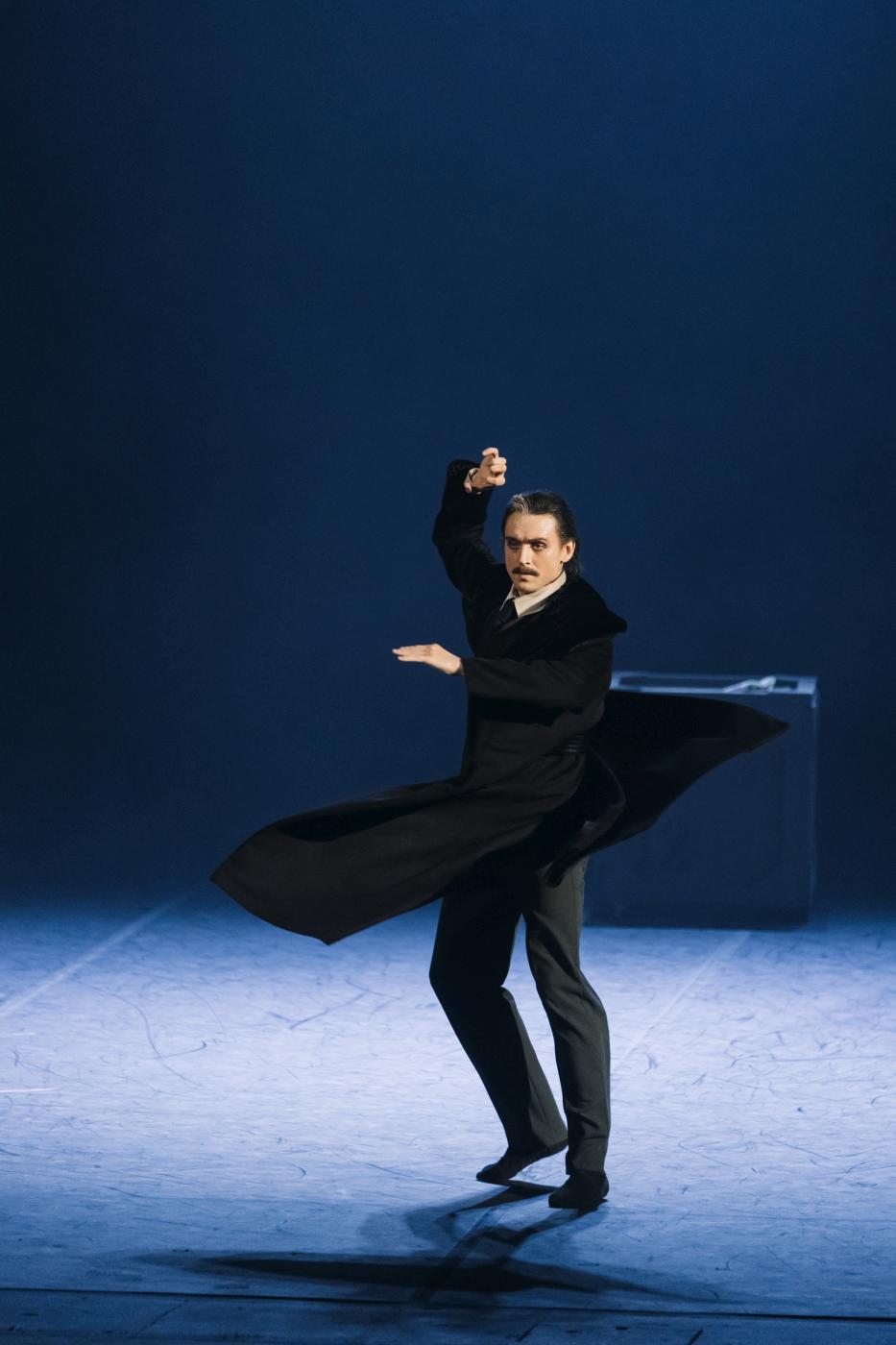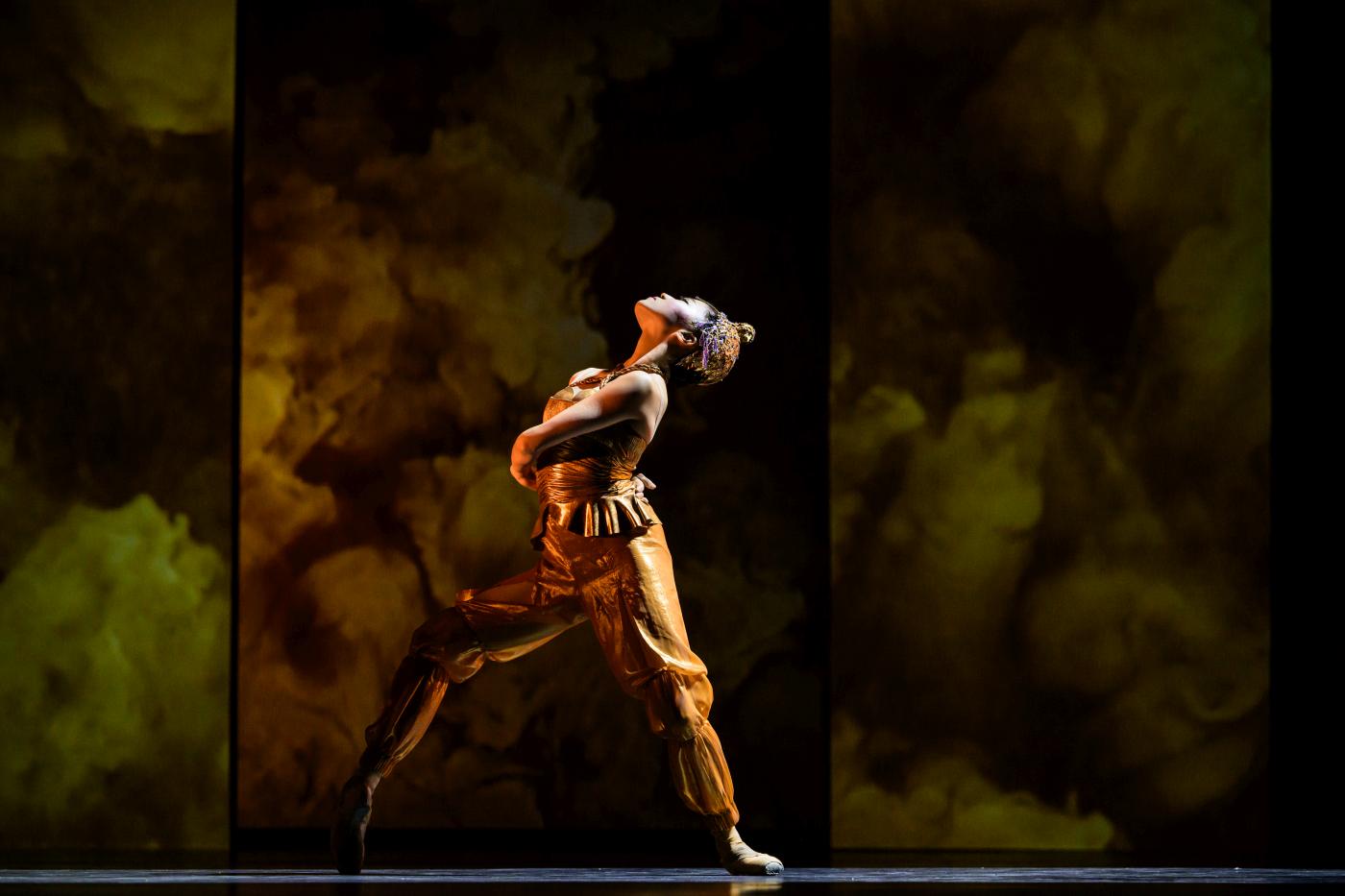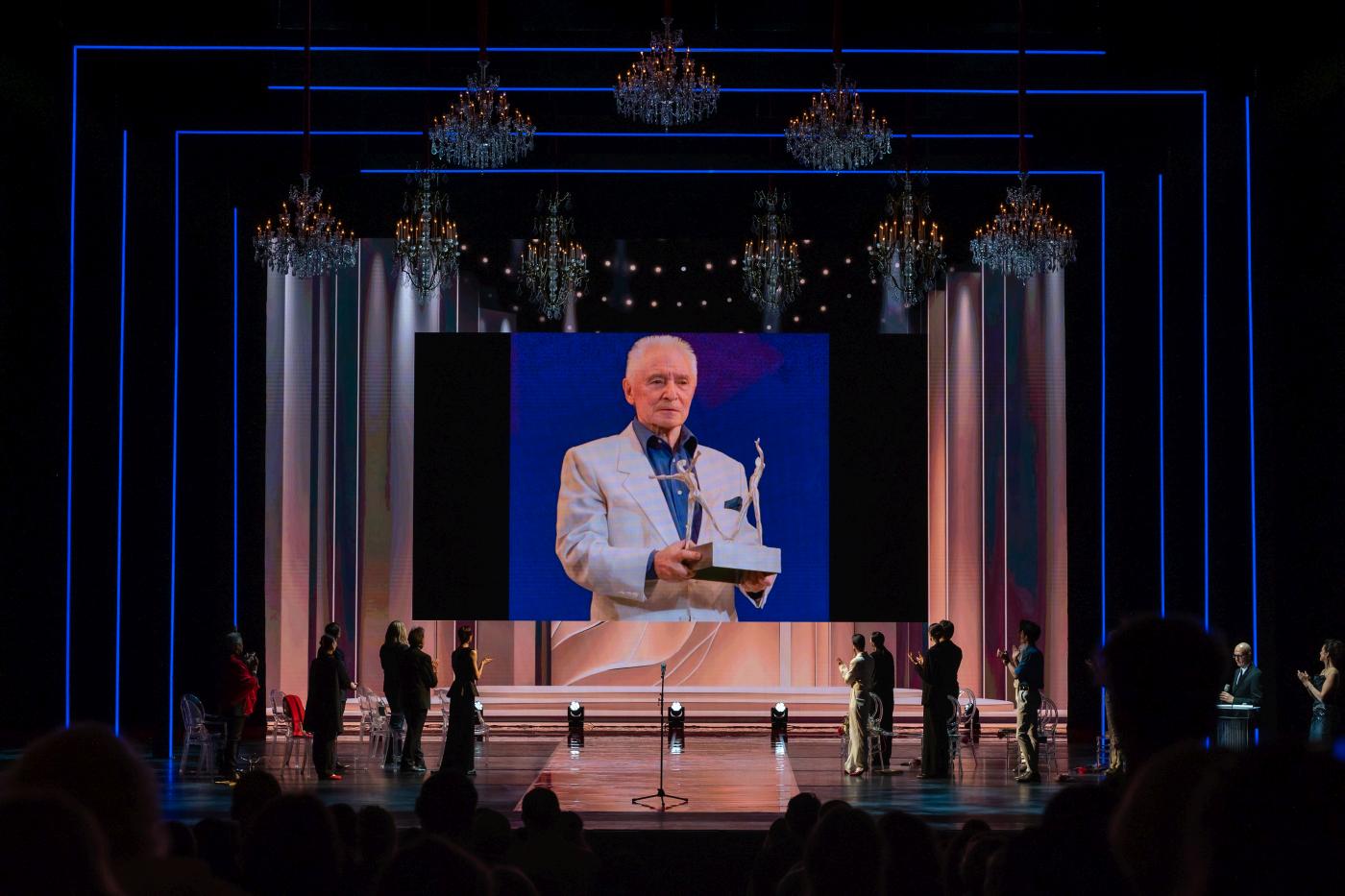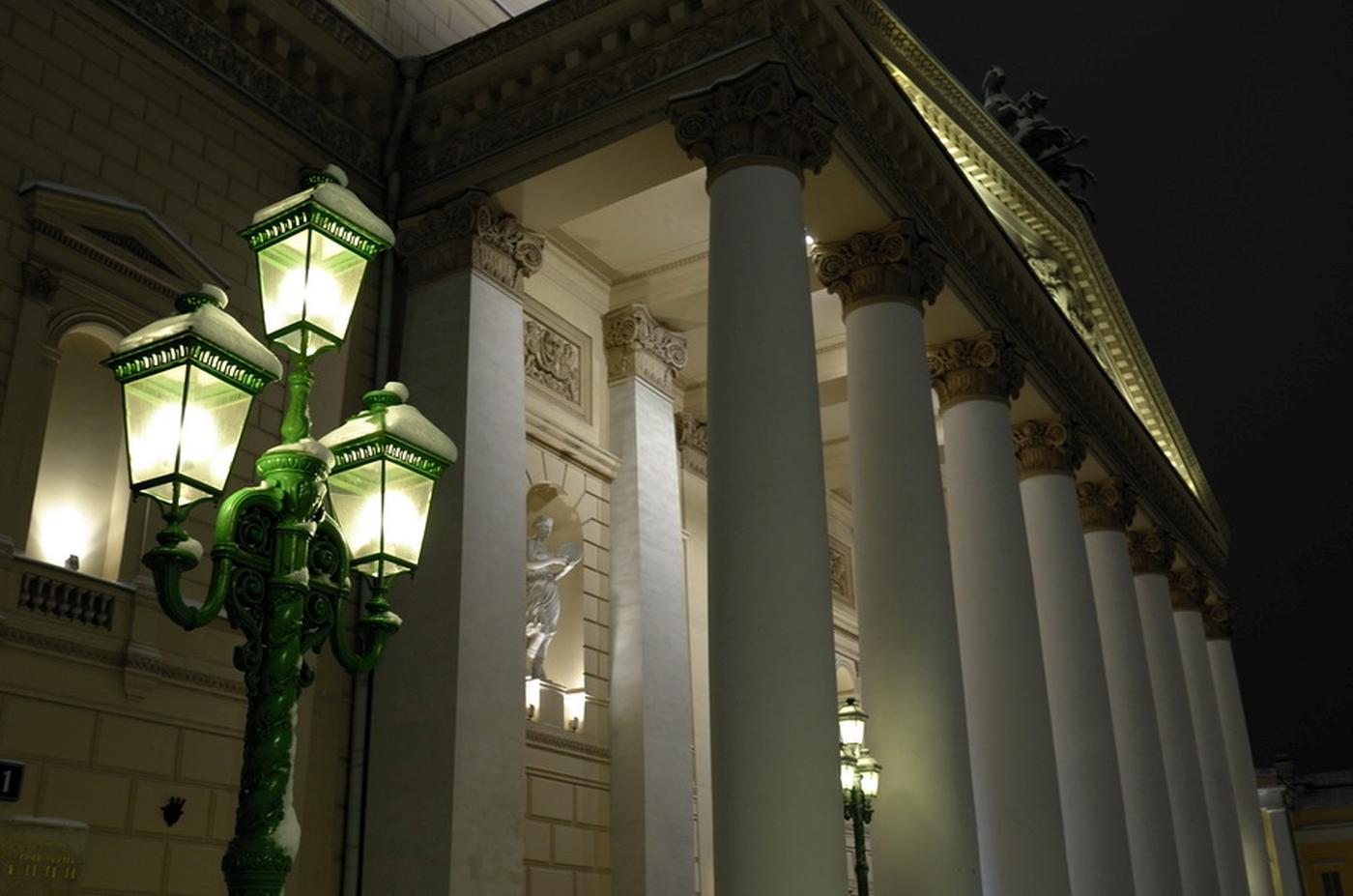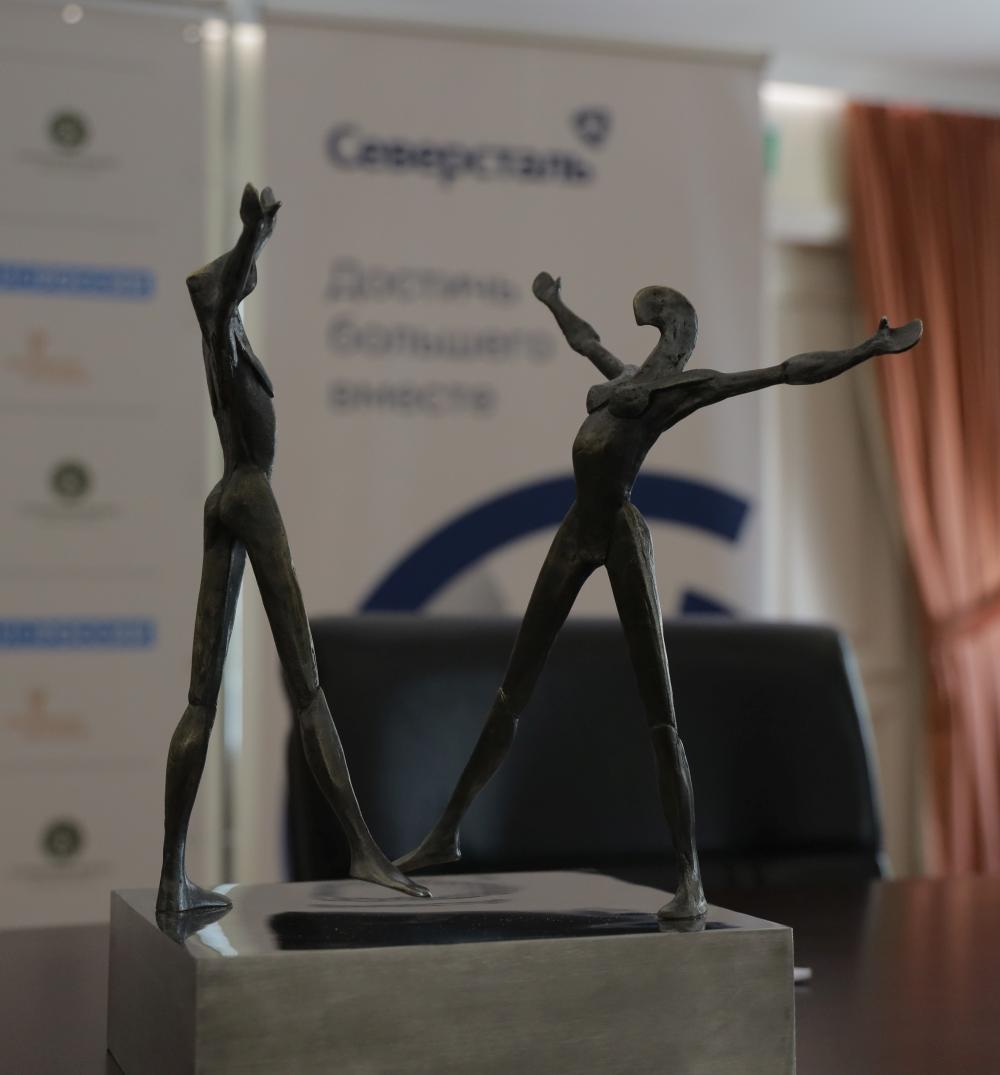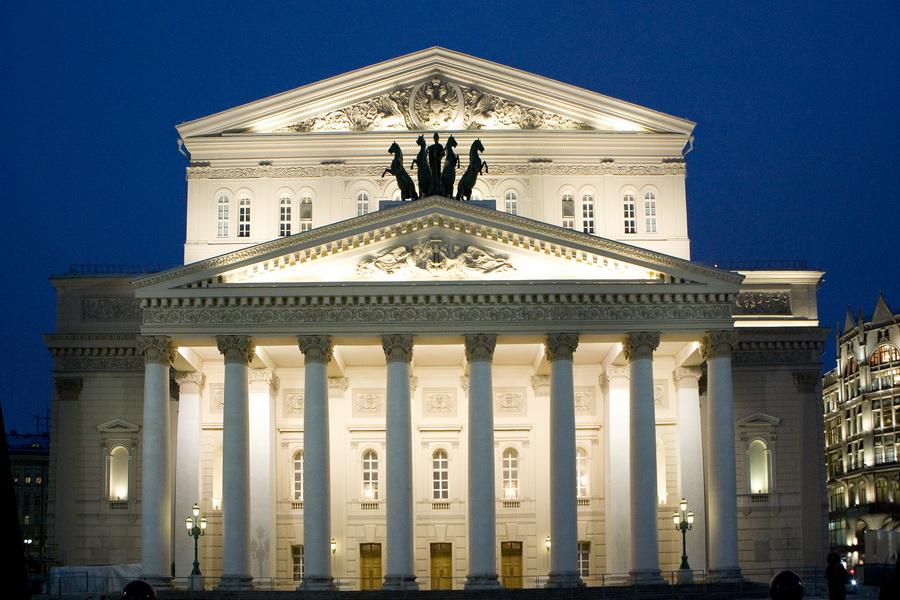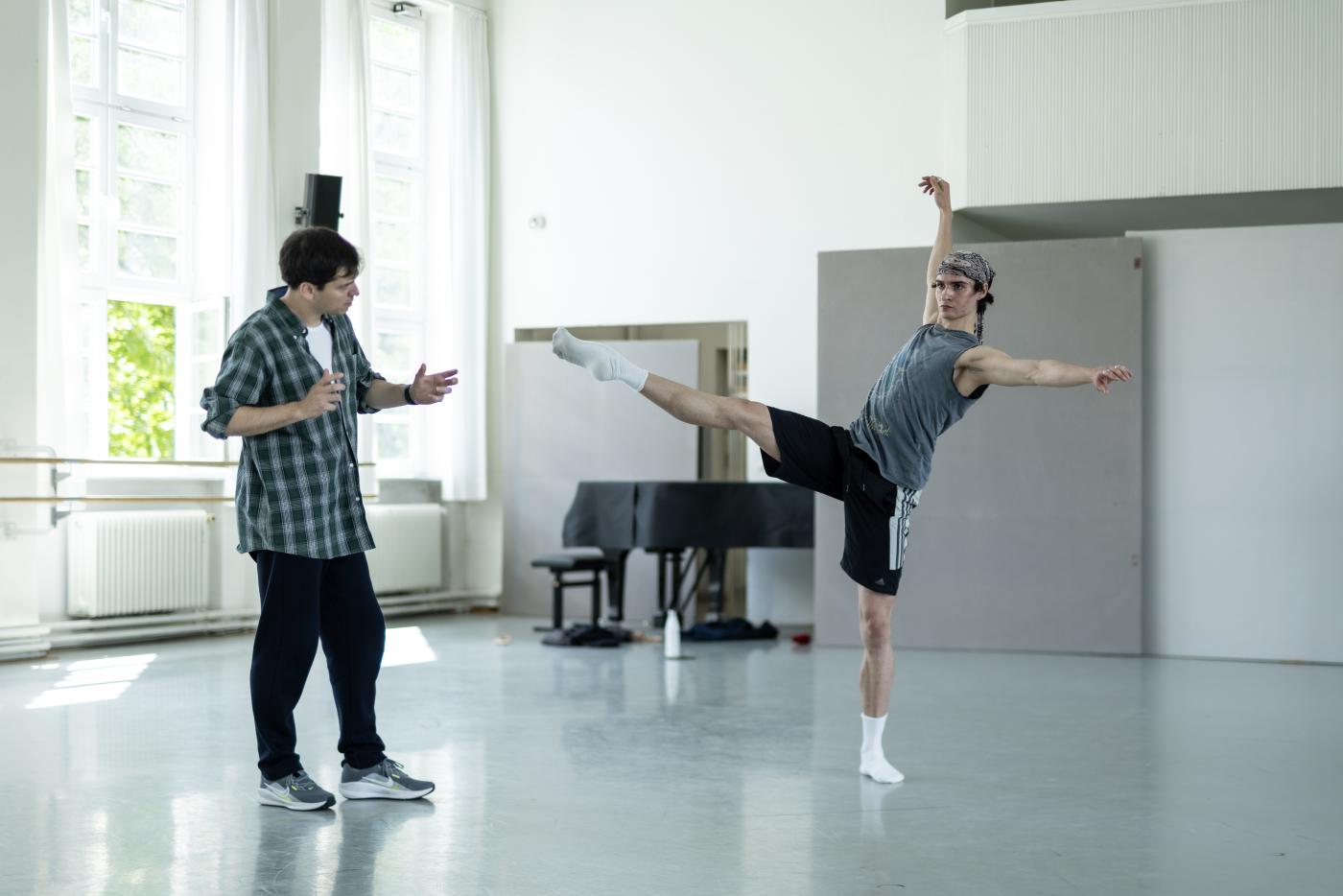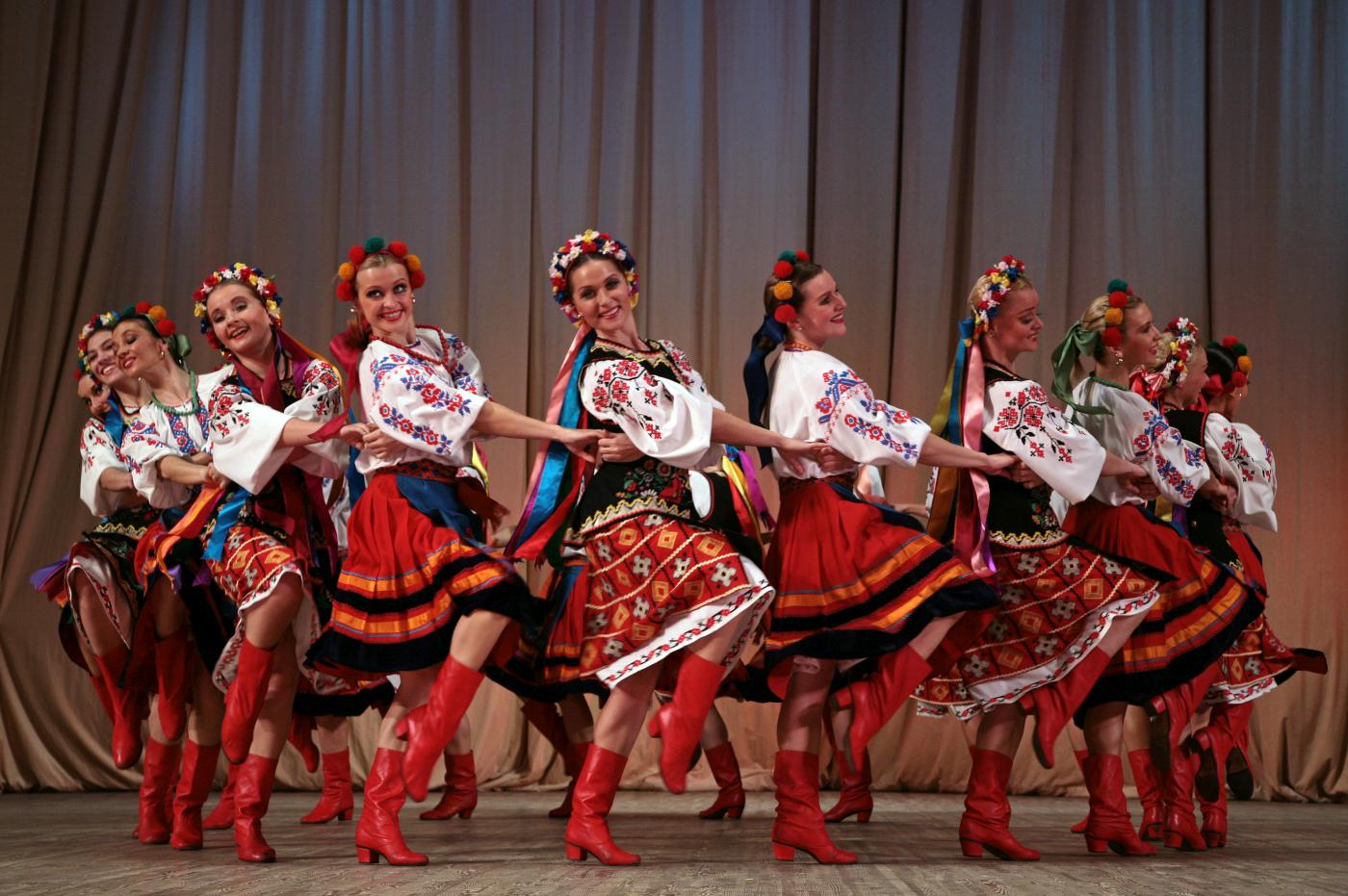“Romeo and Juliet”
Hungarian National Ballet
Hungarian State Opera
Budapest, Hungary
November 8-9, 2025 (evening performance and matinee)
by Ilona Landgraf
Copyright © 2025 by Ilona Landgraf
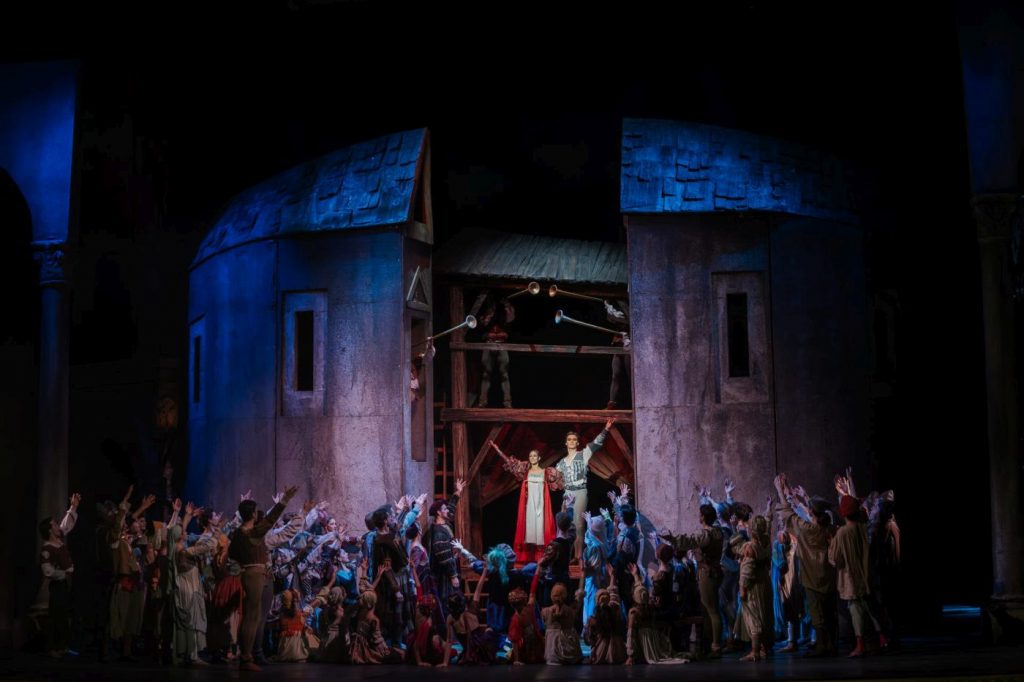 Most ballet companies have a version of Romeo and Juliet. The Hungarian National Ballet’s version, by László Seregi (1929-2012), has been on the program regularly since its premiere in 1985. A crowd puller, the opera house was sold out at both performances I watched.
Most ballet companies have a version of Romeo and Juliet. The Hungarian National Ballet’s version, by László Seregi (1929-2012), has been on the program regularly since its premiere in 1985. A crowd puller, the opera house was sold out at both performances I watched.
Seregi’s name is well known to Hungarian ballet lovers. Initially trained as a folk dancer, he joined the opera’s corps de ballet when it was short on artists during the 1956 revolution. In 1977, he became the company’s director but, feeling burdened by his duties, suffered from an enduring artistic crisis.
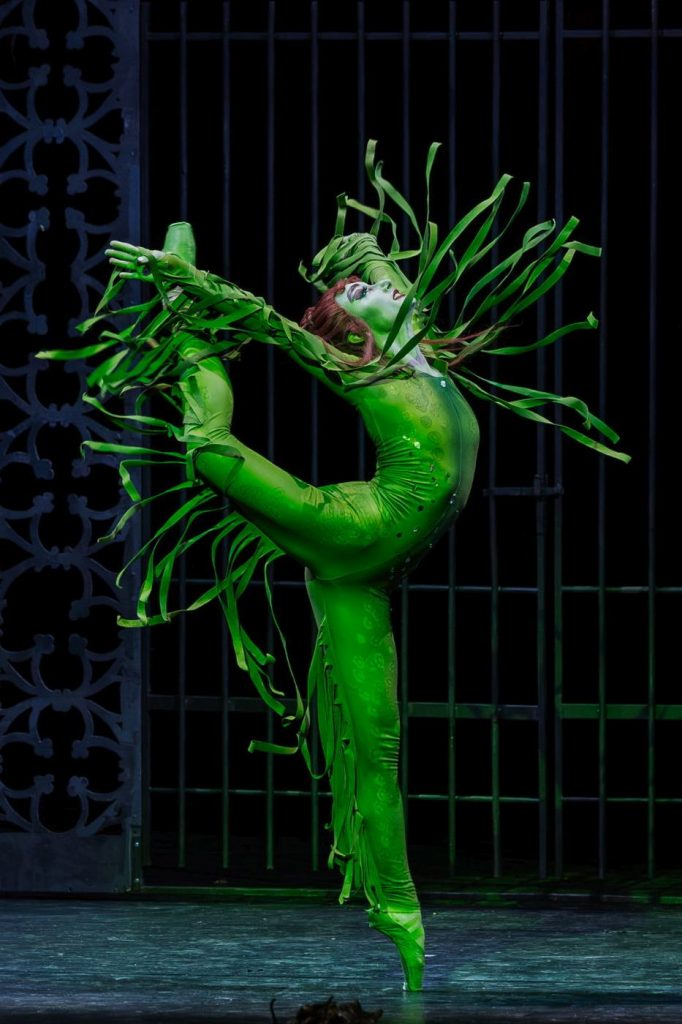
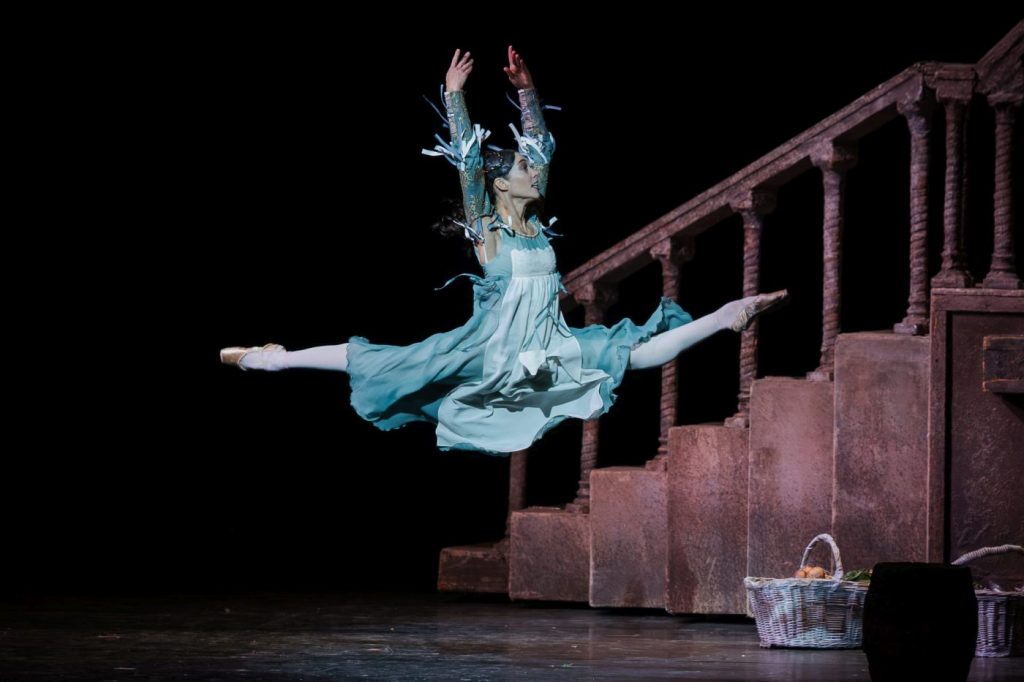 Creativity burgeoned anew when the government accepted his resignation in 1983. Of Seregi’s earlier pieces, the 1968 Spartacus (of which I saw a snippet at a 2023 gala) is the most famous. Romeo and Juliet is part of his Shakespeare trilogy, which additionally comprises A Midsummer Night’s Dream (1989) and The Taming of the Shrew (1994). Plans for The Tempest were aborted.
Creativity burgeoned anew when the government accepted his resignation in 1983. Of Seregi’s earlier pieces, the 1968 Spartacus (of which I saw a snippet at a 2023 gala) is the most famous. Romeo and Juliet is part of his Shakespeare trilogy, which additionally comprises A Midsummer Night’s Dream (1989) and The Taming of the Shrew (1994). Plans for The Tempest were aborted.
In several of his quotes, Seregi pointed to Franco Zeffirelli’s Oscar-decorated screen adaption from 1968 as the main source of inspiration for Romeo and Juliet.

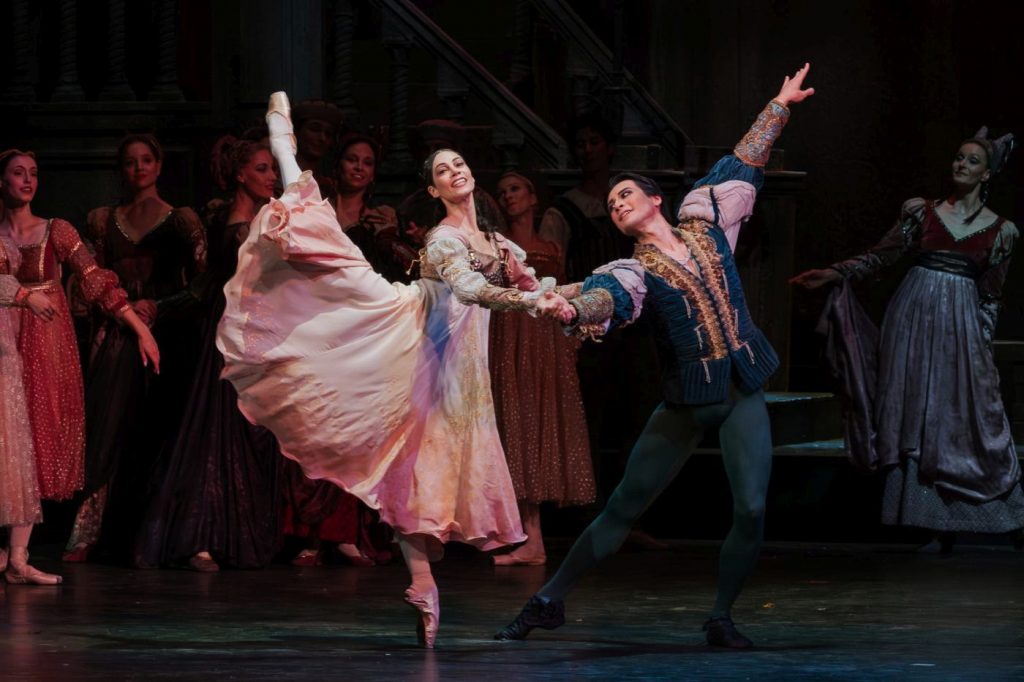 Seregi’s Juliet leaned on the balustrade of her balcony while yearning for Romeo in the same way Zeffirelli’s did, and both Romeos climbed a tree as quick as a flash to reach her. The only difference was that Budapest’s tree was leafless, which forced Romeo to hide under his coat like a super-sized bat until the coast was clear from the pesky Tybalt.
Seregi’s Juliet leaned on the balustrade of her balcony while yearning for Romeo in the same way Zeffirelli’s did, and both Romeos climbed a tree as quick as a flash to reach her. The only difference was that Budapest’s tree was leafless, which forced Romeo to hide under his coat like a super-sized bat until the coast was clear from the pesky Tybalt.
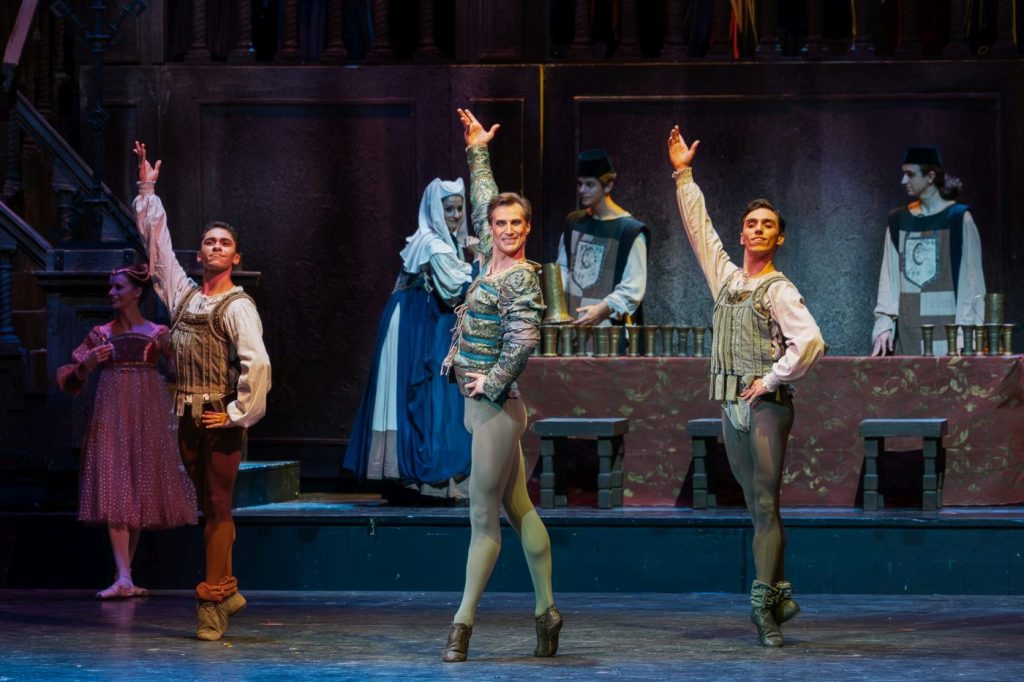
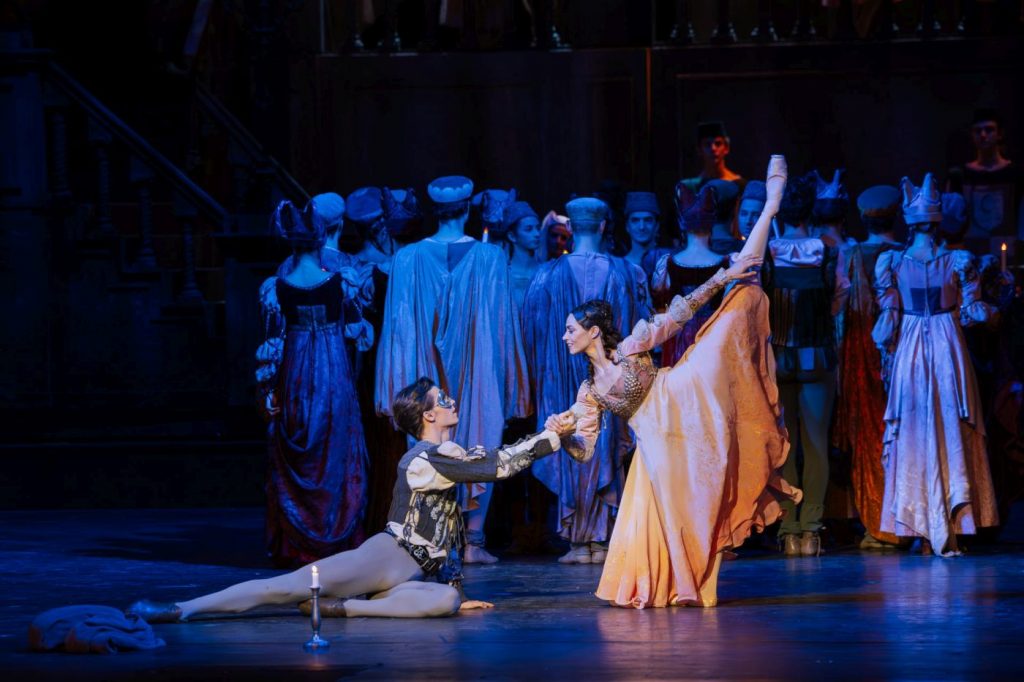 Both the film and the ballet caricatured the pompous entrance of Juliet’s nurse, whose canopy-like veil was ridiculous. Seregi’s Friar Laurence inspected Romeo’s pupils for a lack of sleep before tousling his hair just as his film counterpart did. Furthermore, the fingers of both Juliets stretched in the same way upon awakening from their death-like slumber.
Both the film and the ballet caricatured the pompous entrance of Juliet’s nurse, whose canopy-like veil was ridiculous. Seregi’s Friar Laurence inspected Romeo’s pupils for a lack of sleep before tousling his hair just as his film counterpart did. Furthermore, the fingers of both Juliets stretched in the same way upon awakening from their death-like slumber.
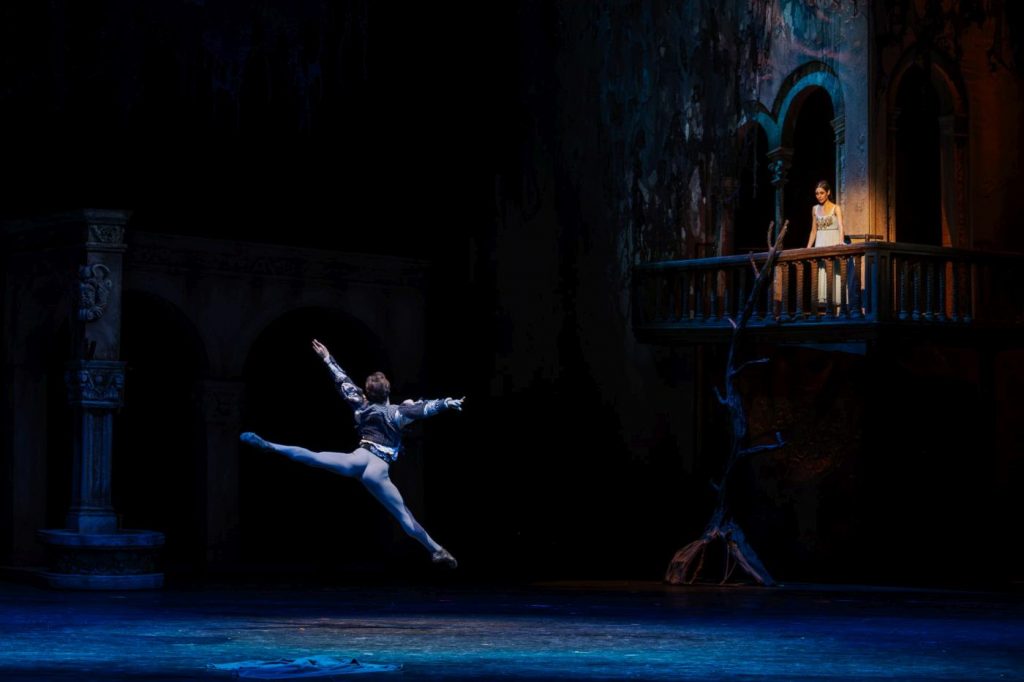
 Nevertheless, Seregi’s version is no copy of Zeffirelli’s. There is no doubt that its home is the theater, specifically London’s Globe Theatre. We watched its polygon walls (designed by Gábor Forray) from outside together with an on-stage crowd. It cheered the artists, who in turn greeted them from the Globe’s small stage. It was 1595 or so, and the premiere of Romeo and Juliet was about to unfold.
Nevertheless, Seregi’s version is no copy of Zeffirelli’s. There is no doubt that its home is the theater, specifically London’s Globe Theatre. We watched its polygon walls (designed by Gábor Forray) from outside together with an on-stage crowd. It cheered the artists, who in turn greeted them from the Globe’s small stage. It was 1595 or so, and the premiere of Romeo and Juliet was about to unfold.
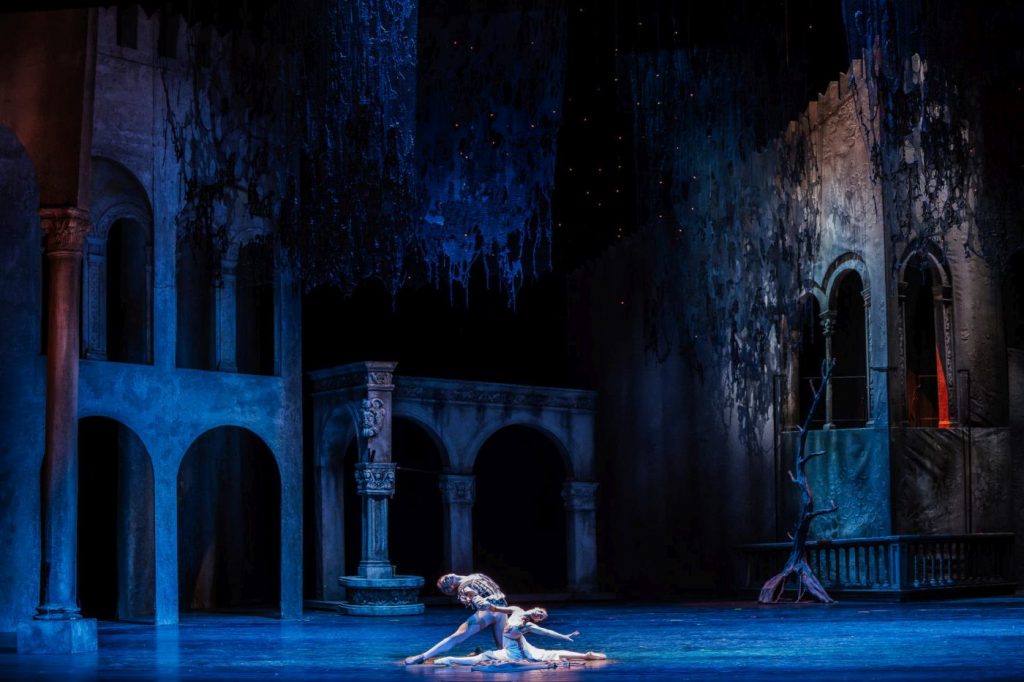
 As the Globe’s doors slid open and its small stage widened into the Budapest opera’s large one, we were transported to Verona’s marketplace. Gray morning light gave its Romanesque architecture a gloomy, austere look. Although Prokofiev’s music suggested otherwise, this seemed to be no place for blossoming love. The marketers and adjacent patrons who stood frozen still began to bustle only after Romeo presented an apple to a girl and bit heartily into his own. They reminded me of Adam and Eve bringing misery to humankind by eating the forbidden fruit.
As the Globe’s doors slid open and its small stage widened into the Budapest opera’s large one, we were transported to Verona’s marketplace. Gray morning light gave its Romanesque architecture a gloomy, austere look. Although Prokofiev’s music suggested otherwise, this seemed to be no place for blossoming love. The marketers and adjacent patrons who stood frozen still began to bustle only after Romeo presented an apple to a girl and bit heartily into his own. They reminded me of Adam and Eve bringing misery to humankind by eating the forbidden fruit.

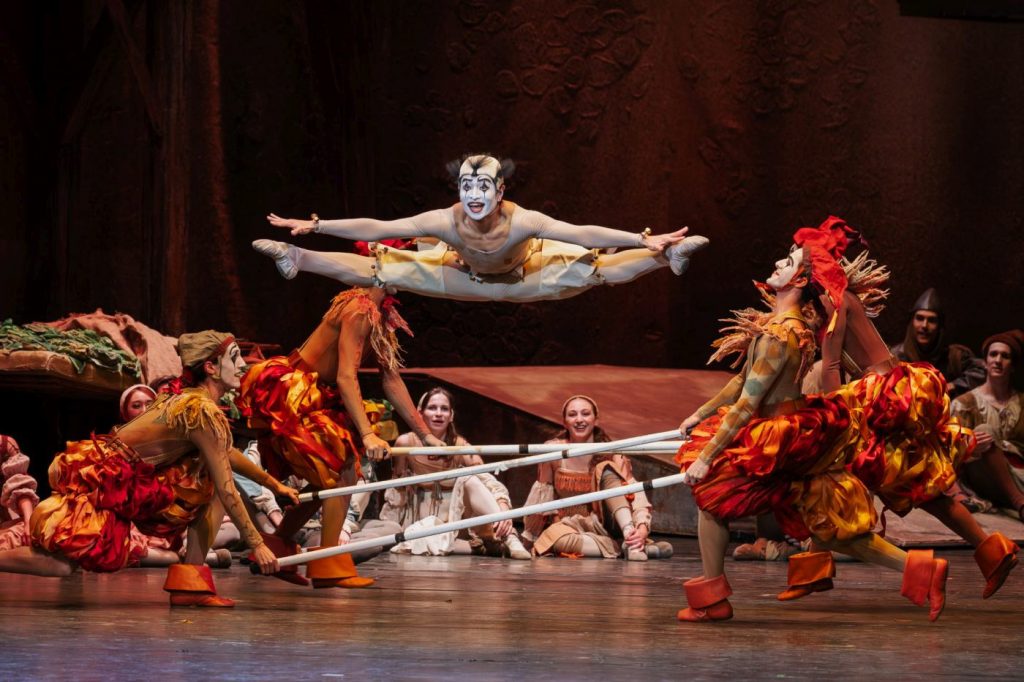 Suddenly, bright sunlight warmed the stone walls, guys chased girls, the whores showcased their charms, and before you knew it, the youth bouncing about beat the daylight out of one another. The Montagues and Capulets both had short fuses that were ignited by trifles. Not even the Prince of Verona’s authority could control their hate. Fencing like berserkers, two men were killed in no time.
Suddenly, bright sunlight warmed the stone walls, guys chased girls, the whores showcased their charms, and before you knew it, the youth bouncing about beat the daylight out of one another. The Montagues and Capulets both had short fuses that were ignited by trifles. Not even the Prince of Verona’s authority could control their hate. Fencing like berserkers, two men were killed in no time.
Happiness and death lay side by side and at times clashed, creating a “tragicomedy.”

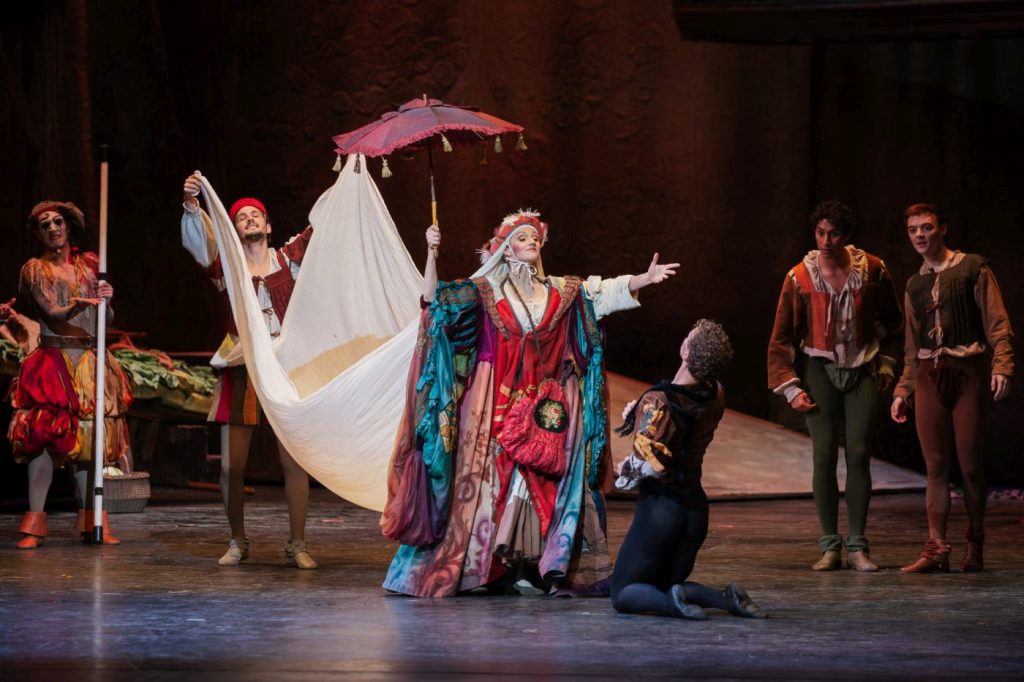 While the lifeless Juliet had yet to be discovered behind her bed drape, the State Opera Orchestra (playing under the baton of Peter Dobszay at both performances) lulled Count Paris, the nurse, and Juliet’s parents with a sweet rendition of the Dance of the Lilies that seemed to mock fate’s imminent blow. Adversity was easier to bear when remembering that all the world’s a stage.
While the lifeless Juliet had yet to be discovered behind her bed drape, the State Opera Orchestra (playing under the baton of Peter Dobszay at both performances) lulled Count Paris, the nurse, and Juliet’s parents with a sweet rendition of the Dance of the Lilies that seemed to mock fate’s imminent blow. Adversity was easier to bear when remembering that all the world’s a stage.
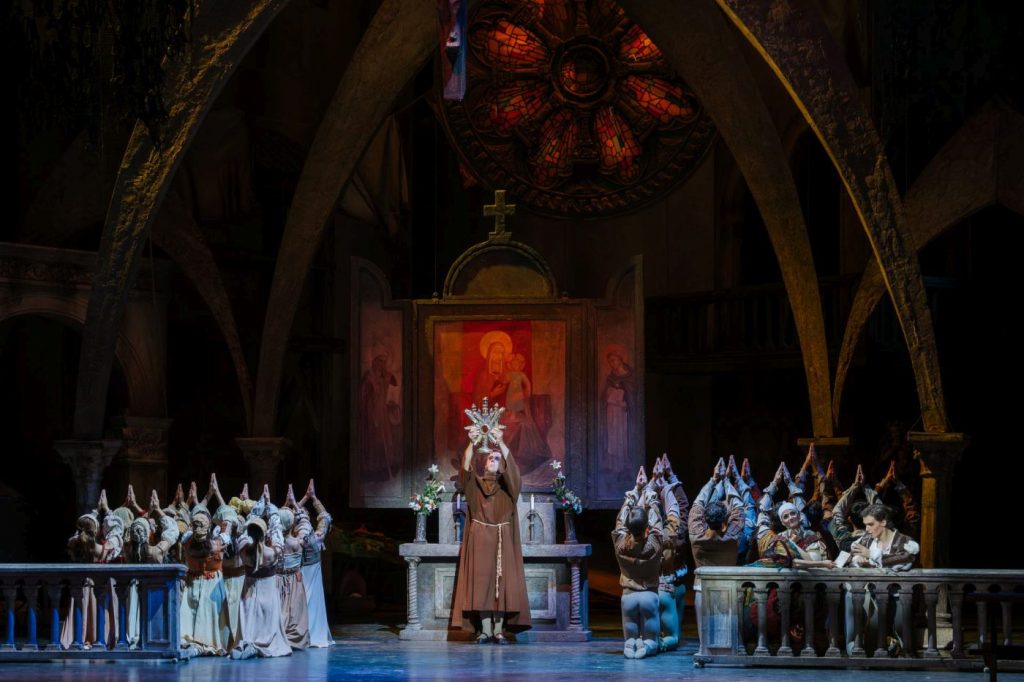
 While Zeffirelli’s Prince of Verona condemned his subjects with a thunderous, “You’re all punished!” at the lovers’ bier, Seregi’s Prince didn’t appear again. Heaven had predetermined Romeo and Juliet to be star-crossed lovers (and the stars twinkled twice during their short romance—during the balcony scene and at the crypt) and, whether a prince or not, no one could do anything about it.
While Zeffirelli’s Prince of Verona condemned his subjects with a thunderous, “You’re all punished!” at the lovers’ bier, Seregi’s Prince didn’t appear again. Heaven had predetermined Romeo and Juliet to be star-crossed lovers (and the stars twinkled twice during their short romance—during the balcony scene and at the crypt) and, whether a prince or not, no one could do anything about it.
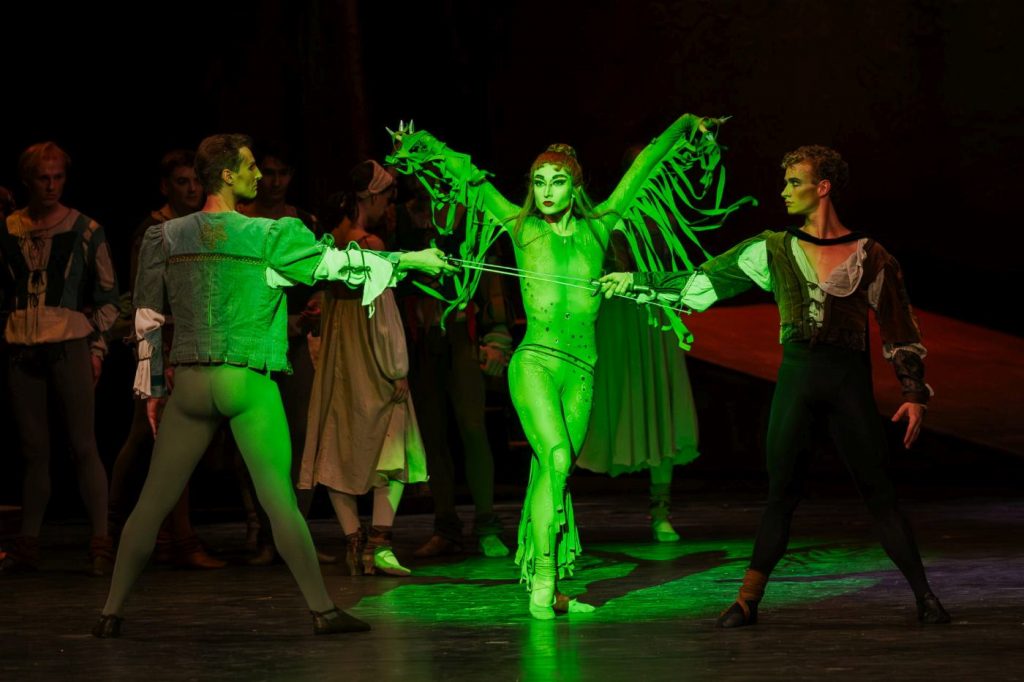
 Unlike other choreographers, Seregi intertwined the sacred with the mundane, especially with lovemaking. The altar of Friar Laurence’s chapel rested on the previous scene’s bed frame, where Romeo and Juliet spent their first and only night together. And the effect of the potion that Friar Laurence handed to Juliet was visualized in the upper part of the retable, where two representatives of the lovers reunited in bed as if it were the essence of divine mystery.
Unlike other choreographers, Seregi intertwined the sacred with the mundane, especially with lovemaking. The altar of Friar Laurence’s chapel rested on the previous scene’s bed frame, where Romeo and Juliet spent their first and only night together. And the effect of the potion that Friar Laurence handed to Juliet was visualized in the upper part of the retable, where two representatives of the lovers reunited in bed as if it were the essence of divine mystery.
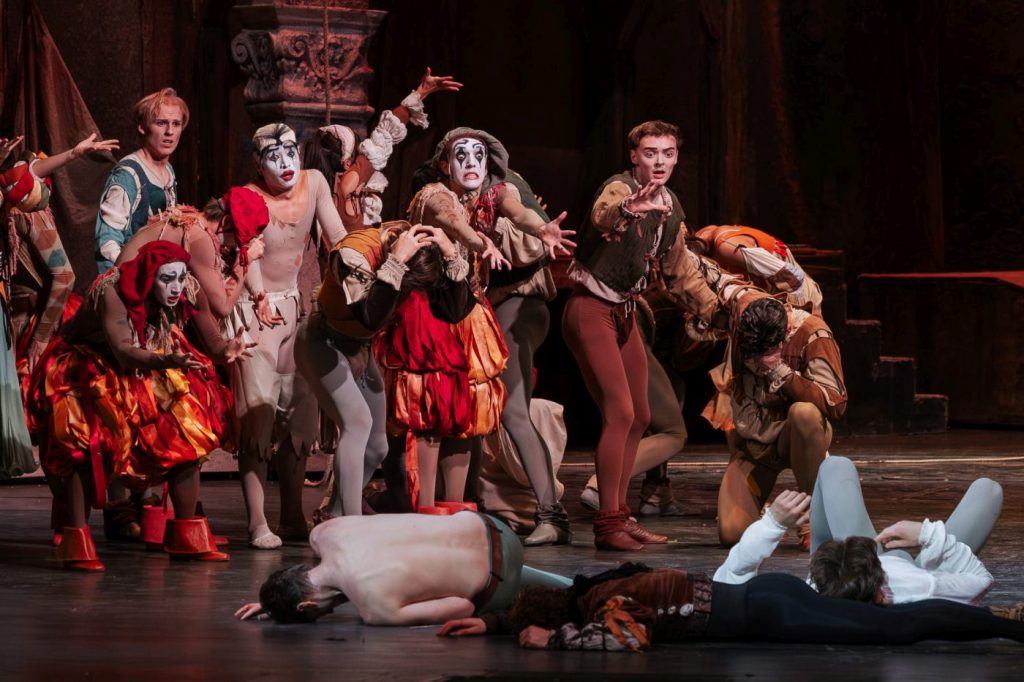
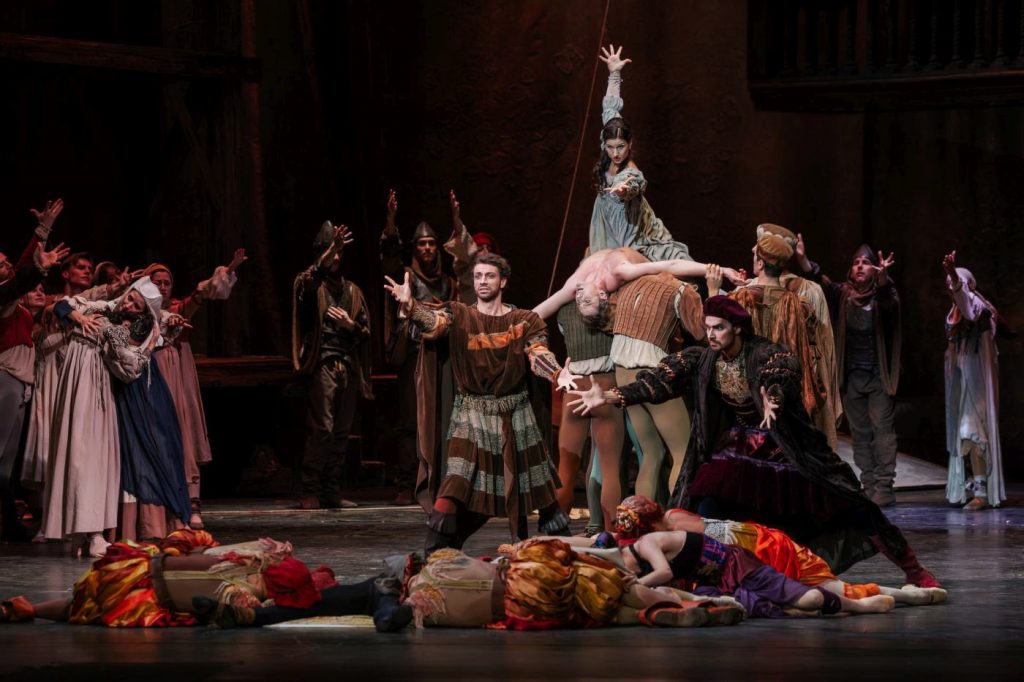 Seregi, who admitted that he was most scared when choreographing solos and pas de deux, felt at ease with large groups. “My heartbeat returns to normal pace if there are eighty or a hundred people on stage, then I become inventive, that is when I’m in my element,” he said. Indeed, his bustling group scenes (for which Nelly Vágó’s colorful Renaissance costumes put the cherry on the cake) were superb. The solos and pas de deux varied in quality. Several times, the dancers froze to emphasize the absurdity of the moment or create a time bubble for the lovers’ tête-à-tête.
Seregi, who admitted that he was most scared when choreographing solos and pas de deux, felt at ease with large groups. “My heartbeat returns to normal pace if there are eighty or a hundred people on stage, then I become inventive, that is when I’m in my element,” he said. Indeed, his bustling group scenes (for which Nelly Vágó’s colorful Renaissance costumes put the cherry on the cake) were superb. The solos and pas de deux varied in quality. Several times, the dancers froze to emphasize the absurdity of the moment or create a time bubble for the lovers’ tête-à-tête.
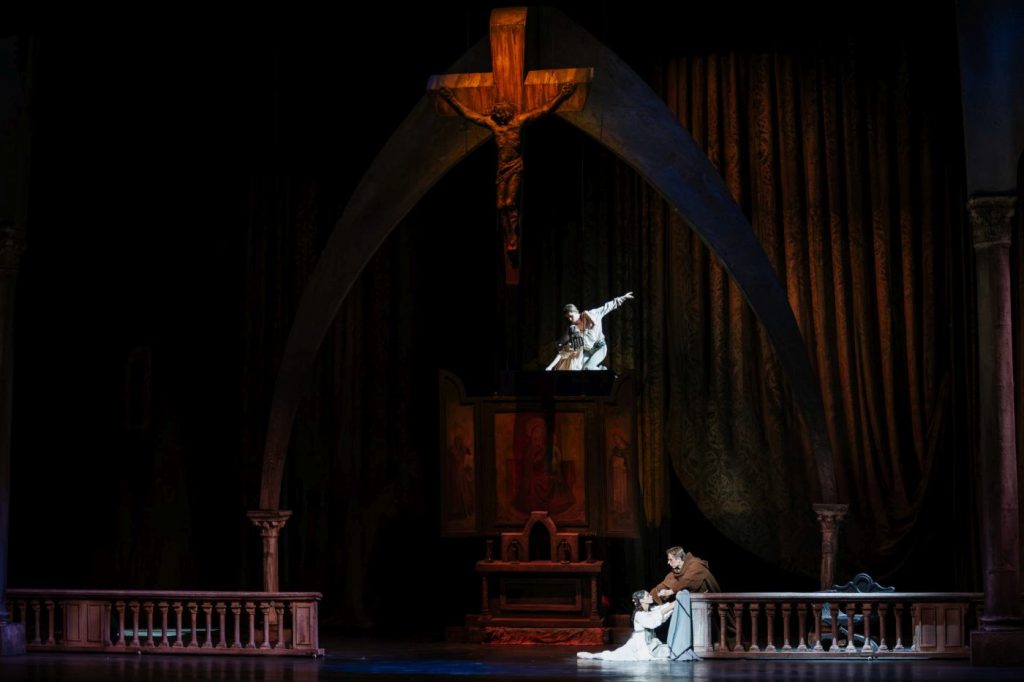
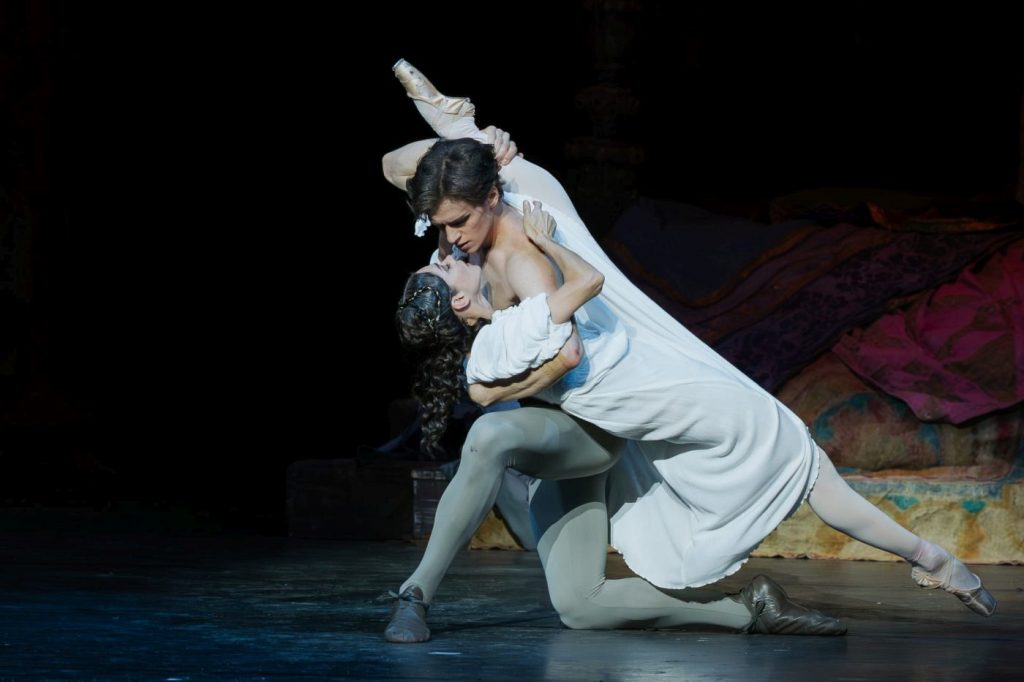 Seregi’s Juliet was a spoon-fed brat, naughty and childish compared to Zeffirelli’s. The mesmerizing love-at-first-sight pas de deux at the Capulets’ ball did wonders to mature her. Romeo’s part at the crypt was disappointing by comparison. Most of the time, he carried Juliet’s cumbersome, limp body, first upstairs, then downstairs, and finally back onto the tomb.
Seregi’s Juliet was a spoon-fed brat, naughty and childish compared to Zeffirelli’s. The mesmerizing love-at-first-sight pas de deux at the Capulets’ ball did wonders to mature her. Romeo’s part at the crypt was disappointing by comparison. Most of the time, he carried Juliet’s cumbersome, limp body, first upstairs, then downstairs, and finally back onto the tomb.

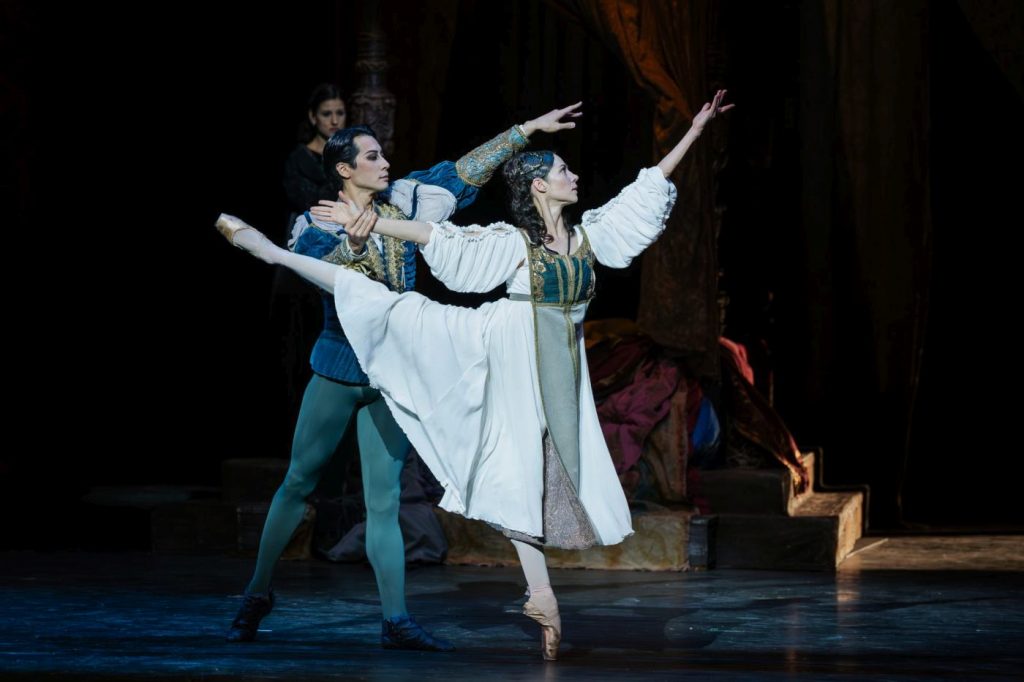 Saturday evening’s leading couple, Maria Yakovleva and Louis Scrivener, melted into one another during their balcony tryst, and from then on, their emotions guided them. The most intense moment of Lili Felméry’s and Dmitry Timofeev’s performance on Sunday morning was at the end. Surrounded by multiple representatives of Romeo and Juliet, both rose from the tomb and raised their eyes toward the audience. Their glances contained the very essence of Romeo and Juliet, the knowledge that this love had to be tragic, as bitter as that might seem. It struck like an invisible flash.
Saturday evening’s leading couple, Maria Yakovleva and Louis Scrivener, melted into one another during their balcony tryst, and from then on, their emotions guided them. The most intense moment of Lili Felméry’s and Dmitry Timofeev’s performance on Sunday morning was at the end. Surrounded by multiple representatives of Romeo and Juliet, both rose from the tomb and raised their eyes toward the audience. Their glances contained the very essence of Romeo and Juliet, the knowledge that this love had to be tragic, as bitter as that might seem. It struck like an invisible flash.

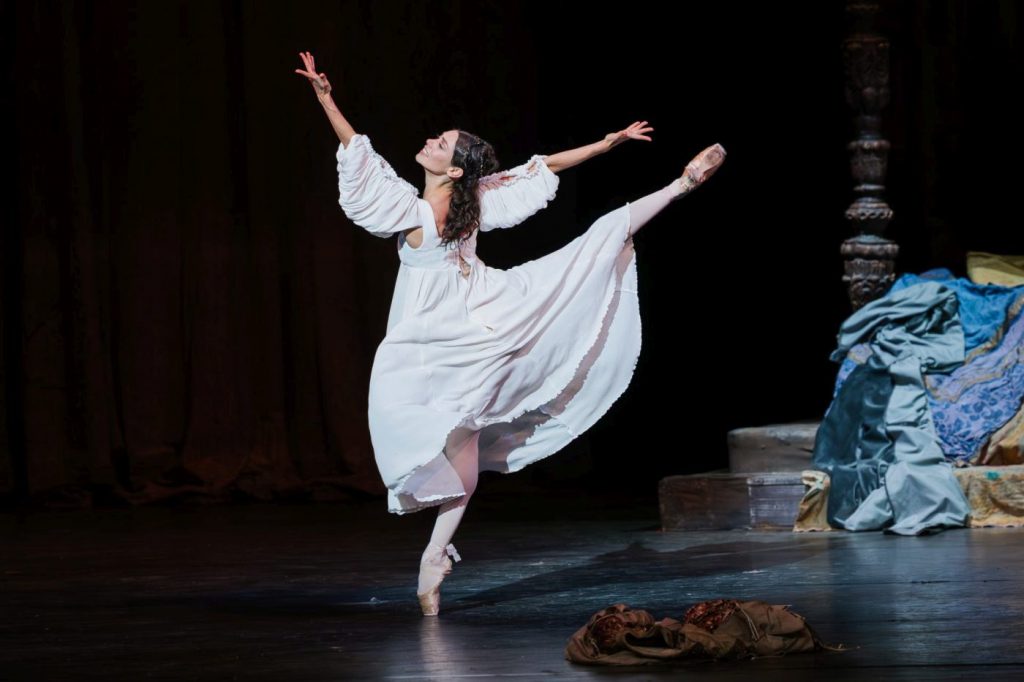 Both Mercutios—Vince Topolánszky’s and Motomi Kiyota’s—were frivolous teasers (again, apples played a major role) and inborn womanizers, darting across the stage as if there was no tomorrow. Mikalai Radziush’s Tybalt was irascible and seemed eaten by wrath from within, whereas Dumitru Taran’s made me hope for a remnant of morals. In any case, the Capulets carried Tybalt’s bare-chested corpse away as if he were Christ Crucified.
Both Mercutios—Vince Topolánszky’s and Motomi Kiyota’s—were frivolous teasers (again, apples played a major role) and inborn womanizers, darting across the stage as if there was no tomorrow. Mikalai Radziush’s Tybalt was irascible and seemed eaten by wrath from within, whereas Dumitru Taran’s made me hope for a remnant of morals. In any case, the Capulets carried Tybalt’s bare-chested corpse away as if he were Christ Crucified.
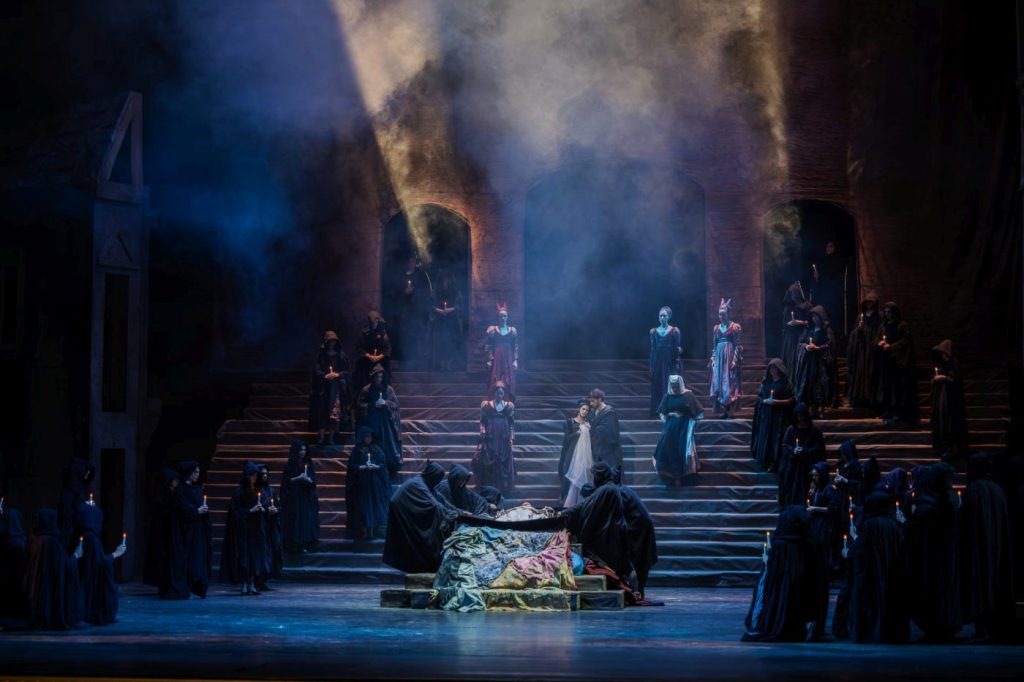 Count Paris’s (Takaaki Okajima/Valerio Palumbo) true nature was revealed when his decorum slipped away and he groped Juliet’s breasts. The nurse (Katerina Taraszova/Ludmilla Taran) was most heartwarming when bursting with glee about facilitating the marriage. The tirelessly jumping clown (Riko Yamamoto/Yago Guerra) that entertained Verona’s folk (the parkour of poles provided by his companions was quite a challenge) gathered much more public interest than the procession of the Virgin Mary.
Count Paris’s (Takaaki Okajima/Valerio Palumbo) true nature was revealed when his decorum slipped away and he groped Juliet’s breasts. The nurse (Katerina Taraszova/Ludmilla Taran) was most heartwarming when bursting with glee about facilitating the marriage. The tirelessly jumping clown (Riko Yamamoto/Yago Guerra) that entertained Verona’s folk (the parkour of poles provided by his companions was quite a challenge) gathered much more public interest than the procession of the Virgin Mary.
Before Budapest, I hadn’t seen Queen Mab, the malevolent hag described in Mercutio’s monologue in the literature source included in Romeo and Juliet. She appeared twice. Resembling a bilious green serpent, Mab (Lea Földi/Maria Beck) gave Romeo, Mercutio, and Benvolio (Viachaslau Hnedchyk/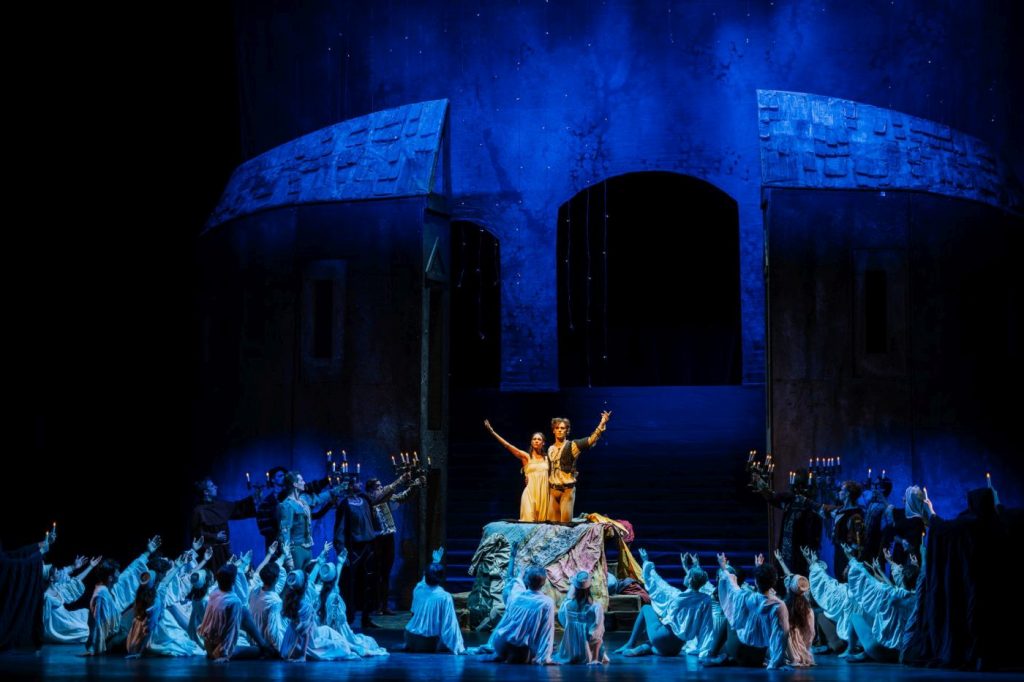 Alberto Ortega de Pablos) the momentum to join the Capulets’ ball and, later, wriggled around Tybalt and Mercutio before their decisive duel. As her teeth fastened onto the blades of their brandished swords, the Capulets’ and Montagues’ feud seemed sealed for eternity. Long fringes on Mab’s arms and legs extended the radius of her fateful force.
Alberto Ortega de Pablos) the momentum to join the Capulets’ ball and, later, wriggled around Tybalt and Mercutio before their decisive duel. As her teeth fastened onto the blades of their brandished swords, the Capulets’ and Montagues’ feud seemed sealed for eternity. Long fringes on Mab’s arms and legs extended the radius of her fateful force.
Saturday’s Lord and Lady Capulet were portrayed by Vlagyiszlav Melnyik and Zsófia Gyarmati, and Sunday’s by Iurii Kekalo and Zsuzsanna Papp. Melnyik’s performance was especially strong. Ricardo Vila M. and Maxim Kovtun played the role of Friar Laurence; Iurii Kekalo and Győrgy Szirb alternated as Prince of Verona.
| Links: | Website of the Hungarian State Opera | |
| “Romeo and Juliet”—Trailer | ||
| Photos: | 1. | Maria Yakovleva (Juliet), Louis Scrivener (Romeo), and ensemble; “Romeo and Juliet” by László Seregi, Hungarian National Ballet 2025 |
| 2. | Maria Yakovleva (Juliet), “Romeo and Juliet” by László Seregi, Hungarian National Ballet 2025 | |
| 3. | Lea Földi (Queen Mab), “Romeo and Juliet” by László Seregi, Hungarian National Ballet 2025 | |
| 4. | Ensemble, “Romeo and Juliet” by László Seregi, Hungarian National Ballet 2025 | |
| 5. | Maria Yakovleva (Juliet) and Takaaki Okajima (Count Paris), “Romeo and Juliet” by László Seregi, Hungarian National Ballet 2025 | |
| 6. | Louis Scrivener (Romeo), Maria Yakovleva (Juliet), and ensemble; “Romeo and Juliet” by László Seregi, Hungarian National Ballet 2025 | |
| 7. | Mikalai Radziush (Tybalt) and ensemble, “Romeo and Juliet” by László Seregi, Hungarian National Ballet 2025 | |
| 8. | Louis Scrivener (Romeo) and Maria Yakovleva (Juliet), “Romeo and Juliet” by László Seregi, Hungarian National Ballet 2025 | |
| 9. | Louis Scrivener (Romeo) and Maria Yakovleva (Juliet), “Romeo and Juliet” by László Seregi, Hungarian National Ballet 2025 | |
| 10. | Maria Yakovleva (Juliet) and Louis Scrivener (Romeo), “Romeo and Juliet” by László Seregi, Hungarian National Ballet 2025 | |
| 11. | Louis Scrivener (Romeo) and Maria Yakovleva (Juliet), “Romeo and Juliet” by László Seregi, Hungarian National Ballet 2025 | |
| 12. | Riku Yamamoto (Clown) and ensemble, “Romeo and Juliet” by László Seregi, Hungarian National Ballet 2025 |
|
| 13. | Riku Yamamoto (Clown) and ensemble, “Romeo and Juliet” by László Seregi, Hungarian National Ballet 2025 | |
| 14. | Ludmilla Taran (Nurse), Vince Topolánszky (Mercutio), and ensemble; “Romeo and Juliet” by László Seregi, Hungarian National Ballet 2025 | |
| 15. | Ludmilla Taran (Nurse), Louis Scrivener (Romeo), and ensemble; “Romeo and Juliet” by László Seregi, Hungarian National Ballet 2025 | |
| 16. | Maxim Kovtun (Friar Laurence) and ensemble, “Romeo and Juliet” by László Seregi, Hungarian National Ballet 2025 | |
| 17. | Maxim Kovtun (Friar Laurence), Maria Yakovleva (Juliet), and Louis Scrivener (Romeo); “Romeo and Juliet” by László Seregi, Hungarian National Ballet 2025 | |
| 18. | Vince Topolánszky (Mercutio), Mikalai Radziush (Tybalt), and ensemble; “Romeo and Juliet” by László Seregi, Hungarian National Ballet 2025 | |
| 19. | Mikalai Radziush (Tybalt), Lea Földi (Queen Mab), and Vince Topolánszky (Mercutio); “Romeo and Juliet” by László Seregi, Hungarian National Ballet 2025 | |
| 20. | Ensemble, “Romeo and Juliet” by László Seregi, Hungarian National Ballet 2025 | |
| 21. | Zsófia Gyarmati (Lady Capulet), Mikalai Radziush (Tybalt), and ensemble; “Romeo and Juliet” by László Seregi, Hungarian National Ballet 2025 | |
| 22. | Maria Yakovleva (Juliet) and Louis Scrivener (Romeo), “Romeo and Juliet” by László Seregi, Hungarian National Ballet 2025 | |
| 23. | Maria Yakovleva (Juliet), Maxim Kovtun (Friar Laurence), and ensemble; “Romeo and Juliet” by László Seregi, Hungarian National Ballet 2025 | |
| 24. | Vlagyiszlav Melnyik (Lord Capulet) and Zsófia Gyarmati (Lady Capulet), “Romeo and Juliet” by László Seregi, Hungarian National Ballet 2025 | |
| 25. | Maria Yakovleva (Juliet) and Takaaki Okajima (Count Paris), “Romeo and Juliet” by László Seregi, Hungarian National Ballet 2025 | |
| 26. | Maria Yakovleva (Juliet), “Romeo and Juliet” by László Seregi, Hungarian National Ballet 2025 |
|
| 27. | Maria Yakovleva (Juliet), “Romeo and Juliet” by László Seregi, Hungarian National Ballet 2025 | |
| 28. | Ensemble, “Romeo and Juliet” by László Seregi, Hungarian National Ballet 2025 | |
| 29. | Maria Yakovleva (Juliet), Louis Scrivener (Romeo), and ensemble; “Romeo and Juliet” by László Seregi, Hungarian National Ballet 2025 | |
| all photos © Attila Nagy/Hungarian State Opera | ||
| Editing: | Kayla Kauffman |
